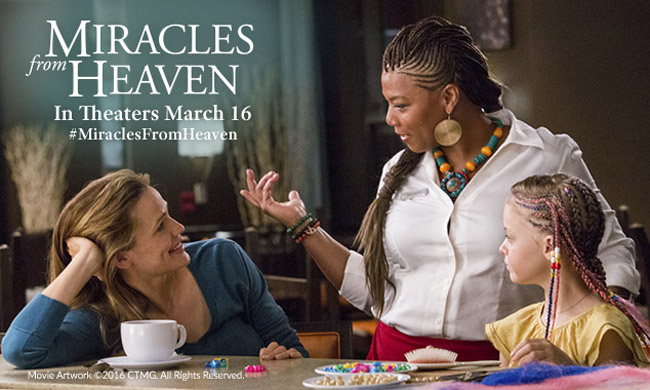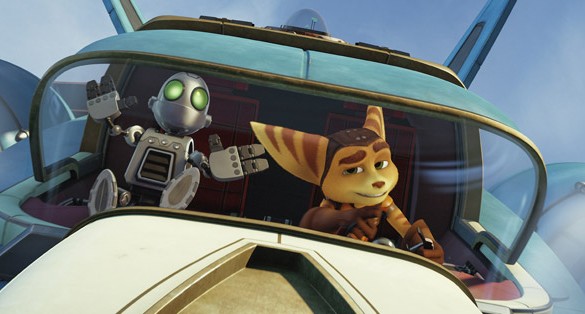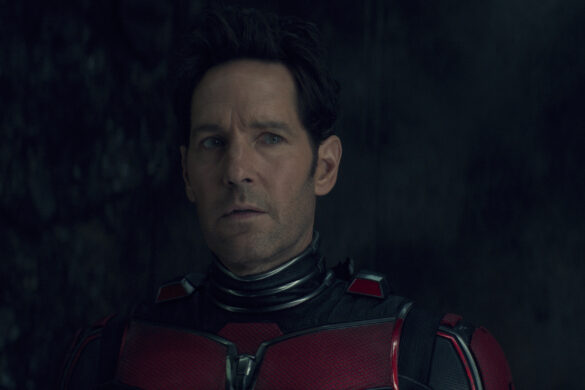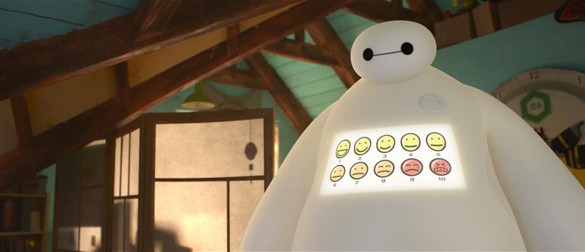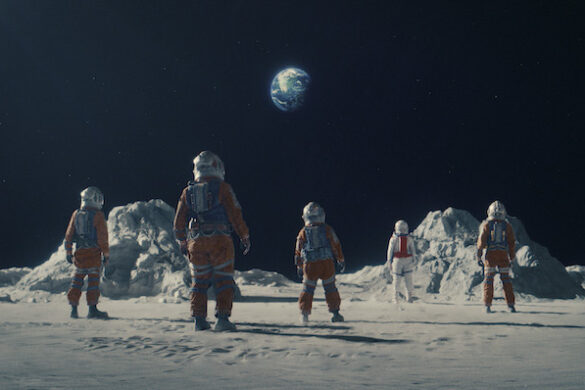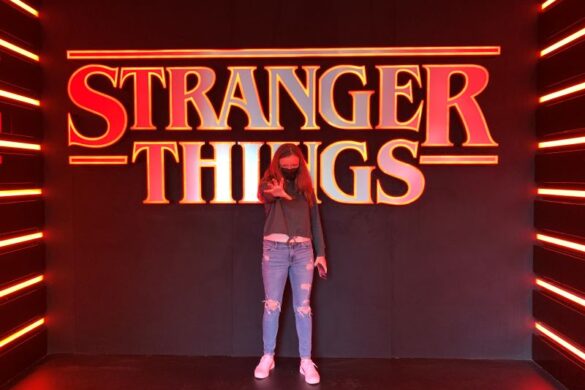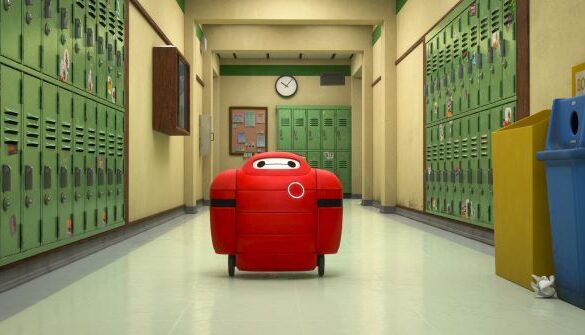Patricia Riggen’s uplifting film, Miracles From Heaven, is an adaptation of Christy Beam’s true-life novel of the same name where Christy’s daughter, Annabelle, is suffering from a pseudo-obstruction motility disorder and is unable to eat. Her faith is put to the ultimate test as treatments for Anna are continuously unsuccessful. One day, a near-death experience lands Anna in the hospital. It is only after she wakes up that the doctors find out that she is cured.
That’s IT LA recently was invited to cover Miracles From Heaven where we sat down with some of the film’s stars like Kylie Rogers, Queen Latifah, Martin Henderson, and Eugenio Derbez. We also sat with Riggen, Brown, and the producers Joe Roth, Bishop T.D. Jakes, and Devon Franklin, who helped bring this emotional story to the big screen.
Below we have nine things we learned about the film from everyone involved, which ranges from the actors relating to their real-life characters, how they build chemistry, casting the right people, and what attracted them to the film.
9 – Relating To Their Real-Life Characters
At the heart of this film is the bond between a mother and her child. The strength of that commitment is unmatched, and for Martin Henderson, who plays the patriarchal Kevin Beam. He believes that Jennifer Garner is a lot like Christy Beam, in terms of being an incredible mother. “It’s true,” said Henderson. “Her devotion to her children is astounding, and something if everybody had that commitment to motherhood, we’d be raising pretty great people. I think she has that in common, her absolute commitment to trying to find help for her daughter, and how tough she had to remain even though her heart was breaking, she has that same attribute for sure.”
Queen Latifah feels that Angela is a reflection of her personality in terms of empathy. “I could totally relate to that. So that’s kinda just what I really wanted to do. Bring some energy,” said Latifah. “They had a lot to continue to do. They hadn’t even shot half the movie by then, so they had a lot deeper to go. It was just cool, because we got to shoot a couple of scenes outside, and get that good energy of being out running across the street, really playing that stuff up, cussing at the people, which they don’t really get to do, I needed to make sure all that was there. Of course, all that was toned down to make sure it was right. But Angela is this different kind of character and that’s the energy she brings. So it was just important for me that I brought that same sort of energy.”
8 – Little Rehearsal Required
The scenes with Latifah and Kylie Rogers, who plays the ill Annabelle Beam, are among the cutest and funniest in the film, and the two talked about how little rehearsal they needed to build chemistry.
“There was a little bit of rehearsal,” said Latifah. “Not much.” Rogers chimed, “We kinda did it.” Latifah added, “It was just cool. We kinda talked a little bit about music, some of the artists we liked that are the same, like Sia. I was like ‘This kid is deep,’ I like that. She’s not like typical people, she went a little deeper. We did a scene when her hair gets braided. We got to like pick which ones. I’m like, ‘Which ones do you want in there?’ We didn’t get a lot of time, but it’s just kinda connecting while we were working and getting to see what she wants to do. And we had a nice junkie car to work in. We do what we do. She’s a seasoned veteran, so I am kinda stealing acting chops from her.”
7 – Actors Meeting Their Real-Life Counterparts And Vice-Versa
Rogers says that she spent a lot of time with the real-life Annabelle Beam, “It’s cool that I am portraying someone that this actually happened to. It’s so crazy that got to meet the person that this happened to.” The young actress did say that one of the biggest challenges of the film was to get the emotions just right. “This is so big that this actually happened to someone. It’s difficult for me to process it sometimes, and there is just so much emotion. I had to get emotional a lot, so I guess that was hard to.”
Eugenio Derbez also met the real-life Dr. Nurko, a pediatric gastroenterologist who is Anna’s doctor at the Boston Children’s Hospital. That was a lot of pressure for the actor to play such person who had a vital role in the Beam’s lives, especially when the real-life doctor came to visit the set. “Having the real Dr. Nurko there. Watching me, play him, it was kind of freaky,” said Derbez. “But I loved it. He’s an amazing human being. Before the movie we talked through Skype many, many times. I went to the hospital in Atlanta with him and Dr. Garza. But the challenge was to how to do ‘this’ or how to do an endoscopy, or how to manage this or that, to obtain the real Dr. Nurko feeling. To see how he is. To portray his soul more than his name, so it was really interesting.” Derbez described the real doctor as shy, but charming at the same time. Like someone you want to hug.
For the real-life Beam, meeting Garner was a once in a lifetime experience. “We had so many good face to face moments together and talks. We related as mothers,” said Beam. The author then spoke about how Garner went the extra mile to portray her just right, “She had the book. She had read it. She had highlighted it, and underlined it, and dogged-eared it, and just read it so many times. And that’s when I knew it was going to be okay because she wanted to know as much as she could know. She poured through the script, then she poured through the book, then she poured back through the script, and back through the book, and asked some really, really great questions, and before they would go do a scene, she would call me ‘Okay, we’re doing the scene, what would you have done during that time?’ Like she wanted to know, it was genuine.”
6 – Finding The Just The Right Actors To Play The Right Person
Beam admits that there was some hesitation from within her own family to find the right actors to portray them. “All of them were nervous,” said Beam, “They were a little concerned, just like ‘who is going to play me?’ Are they able to going to be me?’ I felt like with Jennifer Garner, as brilliant and amazing as she is, you think: ‘how will anyone ever understand what I endured,’ and I think they felt that way too. Annabelle was concerned, and she didn’t voice it to me until later after she met Kylie Rogers, and they had such a great time together. She said, ‘You know mommy, I was really concerned with who was going to play me, but I feel if they let me pick, I wouldn’t have picked as good a choice as they did. Kylie is the best person for me.’ And she was right. And they had all felt that way. And they are all such perfect choices for all three.”
In one of many of Riggen’s conversations with Christy Beam, the director remembers Beam speaking about Dr. Nurko’s humanity. These discussions helped influence her decision to cast Derbez as the real-life doctor. “He brought such a heart, and a beautiful compassion to the doctor, and you can see how much he really cares for the girl. That was very important for me, and the story. I think that he did it brilliantly.”
Henderson said there is a quandary when playing real-life people. “How do I embody this person in spirit and in mind,” asked Henderson. “Kevin and I are not that similar, physically. So then it is like, ‘Oh, how do I try to enact that?’ For me, it is what is the essence of this man, so I went in his environment, and his work, and his home, and his church, and his community. I met some of his friends. We went out to dinner. And I just saw the way she carried himself in those relationships and the way that people responded to him. I was trying to identify what it was about him, his essence, and how do I portray that. I really think the script did a lot of it anyway. I think Patricia felt really strongly about the role of Kevin shouldn’t just be the dad, and she really made an effort to show aspects of his character that made him more than that.”
5 – The Film’s Message.
Riggen spoke about being able to deliver the message of the script. The one thing she wanted the audience to know was miracles like this are very rare, and very few people have this huge gift. “I wanted to make sure the movie gave everyone something else, other than that, and they would find something else in it. I realize that goodness all around us is a part of miracles, what miracles are. I just wanted to make sure that we brought out that message,” said Riggen. “That’s how these flashbacks came about, and how the discovery of Christy Beam came about. When they were going through the struggle and painful journey, there were all these little hands helping along the way, these little angels that showed up at different moments that were helping them through. That is something I think we can all relate to. These difficult times, as moms, as kids, as human beings, we can have our eyes open to goodness all around us.”
Beam says, “The heartbeat of it and message of it is so exactly in line with the heartbeat and message of the book. The book ‘Miracles From Heaven’ is exactly what we lived. It’s the chronicle of everything we endured in the movie and beyond. If you read the book and watch the movie, they compliment each other very well, but they still share the same message.”
4 – Breaking Down Stereotypes And Glass Ceilings
Casting Derbez in this role was also very important for another reason, as it helped break the stereotype that the Latino community mostly plays criminals. “We notice, over here on this side, how important it is to bring these kinds of roles to the screen. They are very rare, if there are any, I can’t think of one. So for us, this is very important, to start bringing positive characters,” said Riggen. “Because there are four million Hispanics in this country, they are not all drug lords and rapists. There are a lot of people that have done a lot of contributions, and work very hard daily. I love the fact that we can bring one of them to the screen.”
Riggen also feels fortunate to be one of the few female directors who have been given the opportunity to tell stories as a filmmaker. She recognizes the small percentage that females represent as directors in a male-dominated position, but she does not let low numbers deter her. “I try to do my best because I have a huge responsibility for all the other ladies that come after me. Because, one that makes a mistake is enough to then dismiss all the rest that are coming behind, because that how women are treated in the world, unfortunately still. I hope this movie is very successful, and it will open doors to other women. We just have to keep building, and fighting, and not let anyone stop us.”
Derbez believes that his role is a huge step forward for the Latino community. The actor said, “Every time you go watch a movie, and there is a Latino, it is always the drug lord, the narco, or probably the cook in the kitchen. Stereotypes. Portraying Harvard and probably number one doctor in that disease, it is proud of us for the entire Latino community, not just the Mexicans, but the entire Hispanic community. So I feel blessed that I have the opportunity to play this amazing human being known as Dr. Nurko”.
3 – What Drew The Cast And Crew To The Film
What helped this film get made was that fact that is resonated with everyone involved and that it was so relatable. Bishop T.D. Jakes, who met the Beams, said their story came from a place of heartfulness and wholeness. “The story was, at times, painful and powerful, and ultimately uplifting,” said Jakes.
Producer Joe Roth added, “You read a lot of material, and so you look for certain things, certainly authenticity being one of them. It felt like an authentic story, a very relatable story. A mother-daughter story, and a story that people can derive hope from. Producer Devon Franklin said the story was a page-turner. He said, “It was just so compelling. In the movie, we condensed the time, it is a year’s time. In real life, it almost happened in five years, and that is what is explored in the book. When you put yourself in that mind frame, dealing with the illness and never giving up, and staying committed, and staying faithful, and figuring out life amidst all of that, it was just so compelling that we really had to figure out how to make it into a movie.”
For the three, they want to tell more “uplifting stories.” Sometimes that would be from a “faith-based perspective, sometimes it will be more family-oriented, sometimes it will be a miracle,” said Jakes. “But I want to attach my brand to things that are uplifting, that are positive, that leave you thoughtful and reflective, and us working together, becoming a dream team.” “There are a lot of nice people in the world, and we lose track of it in the culture we are in now,” added Roth. “I enjoy stories that have the kindness of strangers and leave you hopeful, and make you feel good that you are alive.”
“Outside of the religious faith aspect that is clearly a part of this family’s story, the universality of it, if anyone, unfortunately, found themselves in that themselves in that situation that we would A) have enough faith in whatever source we got that from, to get through it, but also how the film acknowledges they were completely supported by so many other little miracles, that really, if you boil it down, they’re just acts of love. I think we can never really underestimate the effect being loving can have on someone going through something like this. So I hope that if it just speaks to that and the importance of community, whether it is a religious community or not, it’s so important.”
As for what drew Latifah into the project, she felt that it was something that she needed to do to honor God for giving her the opportunity to be in a movie. But mostly it was the idea of miracles. “I like miracles,” she said. “I do believe in miracles. I think just happen. Some people say wow that was a lucky break or how serendipitous that this just happened to you. But for me, some things are just like wow, that is a miracle. Like when you see some crazy thing happen, and some kid comes out of a hole fine just a couple scratches, that’s a miracle to me. I’ve seen it before. For me, I love the magic of that,” said Latifah. To me, miracles are almost magical. They seem fantastical. Like magic happening there in real life. Maybe it is the little kid in me, but there is something special about that kinda makes me feel hopeful, that there is something greater than me happening that makes me excited about life and what happens after life.”
2 – Adapting The Book To Film
Screenwriter Randy Brown says one of the biggest challenges of writing the screenplay was that there was so much information in the book, including medical information. So condensing it all into an hour and 45 minutes and turning a narrative novel into a movie, proved somewhat difficult. “I think conveying all the medical information in a way that is accessible and people digest it instead of falling asleep in the movie was the biggest challenge,” said Brown.
1 – The Collaboration With Author, Filmmakers, And Cast
There was a hugely collaborative process with everyone that was involved in the film. This includes Beam communicating with Brown, Garner, and Riggen. “Randy [Brown] was so wonderful, and he e-mailed and called,” said Beam. She added”We had some great conversations and he asked some really great questions. And I tried to help as much as I could. I was on set, and their hearts were very opened to my thoughts, and my concerns, and my additions. They were so receptive. Jennifer and I got to be fast friends. She had so much to learn. She absorbed it like a sponge, she was so great.”
Latifah talked about her talks with Riggen on finding her character, who she was, and what her motivations were. “I kinda looked to Patricia to give me the direction that I needed to bring in,” said Latifah. “She was just like ‘We need you to bring what you bring. Bring in the humor and good vibes’ and I guess some of the things that you know of me to be. Kinda bring some of that, because they are like in one of the most difficult places in their life in the film and this is what Angela gets to do. She gets to like break it up and relieve the stress a little bit.”

